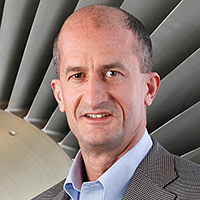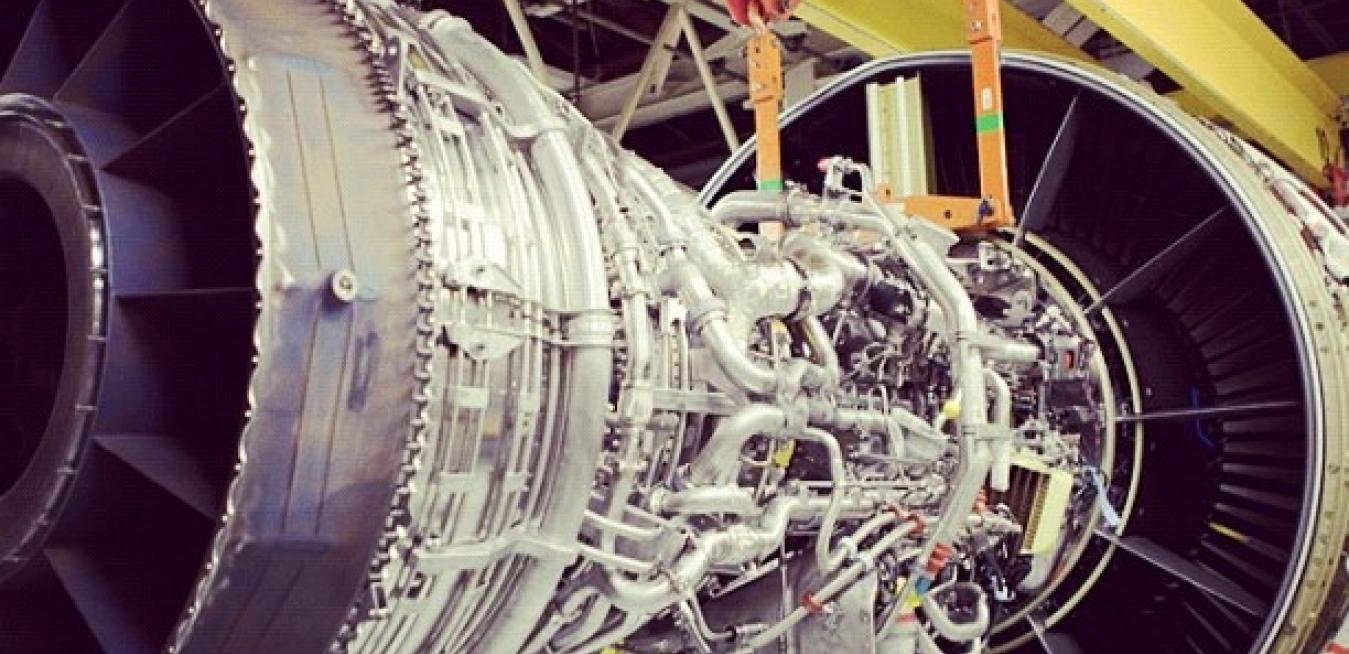This iconic symbol of American aviation is powered by four of GE Aviation’s CF6 turbofan engines. What some people may not realize is that the same engine family is now driving the expansion of one of Asia’s fastest growing airline companies.
GE has a 13-year relationship with AirAsia, during which time we’ve sold the airline more 1,000 jet engines, making them one of the company’s largest aviation customers. Most recently, AirAsiaX—part of the AirAsia Group—signed an agreement to buy an additional 50 CF6 engines to power their new A330 aircraft, allowing the airline to expand services in rapidly growing markets throughout Asia. The deal, which was witnessed by President Barack Obama and Malaysian Prime Minister Datuk Seri Najib Razak, is an example of how strengthened economic ties create growth opportunities for companies in both countries.
A GE CF6-80C2 engine at a GE aviation facility in Cincinnati, OH.
For GE, the ability to sell jet engines globally directly supports the 25,000 engine manufacturing jobs across the US, including facilities in Ohio, North Carolina, Vermont, Maryland, New Hampshire, Massachusetts and Kentucky—and that is without counting the supplier jobs located in 34 states. Some of those U.S. manufactured engines will be serviced in Malaysia at a GE facility that employs more than 250 highly skilled workers who will source products from hundreds of Malaysian suppliers, helping to create jobs locally in small businesses down the supply chain.
GE directly employs over 7,500 people in the ASEAN region, two thirds of them have jobs tied to global trade, but jobs are just the tip of the iceberg. Alongside stable employment come transformative opportunities and benefits for everyone in these communities, regardless whether you live in the U.S. or Malaysia. Vibrant industry attracts new talent, provides new workforce opportunities, and promotes innovation and growth for future generations.
For the AirAsia Group, who recently forecast that some Asian carriers would eventually need more than 1,000 jetliners to meet growing demand, this deal will help support employment for 15,000 staff throughout Asia and beyond. For Asian travelers, expanded access to affordable travel means new opportunities for business and tourism.
As we anticipate greater growth in this region, GE Aviation and AirAsia Group are also committing to reduce fuel consumption and lower emissions. Through a first-of-its-kind partnership in Malaysia, we will work towards growth that is both economically and environmentally sustainable through programs aligned with aims to establish Malaysia as the Centre of Excellence for ‘Greener Skies’ Initiatives in the region. The collaboration, supported by the Malaysian Department of Civil Aviation, will promote the availability of sustainable aviation biofuel sources.
All told, the deal with AirAsia is proof that global collaboration generates local growth opportunities. These kinds of economic benefits can be amplified on a much larger scale, through much discussed free trade agreements like the Trans Pacific Partnership (TPP). The TPP deal currently under negotiation between 12 countries—including Malaysia—would create one of the world’s largest consumer markets. We need these agreements to create rules of the road for global trade that ensure that companies have fair access to global markets and to set standards and expectations that make doing business more predictable for small and large businesses alike.
On a regional level, with the increasing interdependence of the ASEAN economies, integration through the formation of a single market in 2015 through the ASEAN Economic Community (AEC) will bolster growth and competitiveness and promote deeper ties among member countries. AirAsia has been a leading light in enabling the connectivity that the AEC seeks to achieve, a catalyst in helping the region collaborate on an unprecedented scale.
Today, we look for new opportunities in growth and innovation through trade deals like TPP. At GE, we have the ability to innovate and produce one of the best wide body aircraft engines in the world, helping the AirAsia Group pursue its mission to provide affordable air travel that connects never-before linked cities throughout Asia.
Together, our employees are facilitating the growth and empowerment of people and economies all over the world. When we leverage our strengths and assets through global trading partnerships like this one, opportunity and growth take flight.
John G. Rice is vice chairman of GE and president and CEO of GE Global Growth Operations.
Global Trade—Expanding the Future of Flight was originally published on Ideas Lab






